People
How French-Caribbean Artist Julien Creuzet Uses Creole Hymns and Digital Avatars to Retrace African Ancestry
He is set to represent France at the Venice Biennale in 2024.

He is set to represent France at the Venice Biennale in 2024.

Anna Sansom

On the wall of Julien Creuzet’s exhibition at High Art in Paris is a 1976 newspaper article about “the only voodoo temple in Europe.” Published in Le Monde, the story describes a dinner at a time where white Parisians were served by Black “boys and girls” before participating in a frenetic, drum-beating voodoo ceremony. The event took place in the Pigalle district, where High Art is coincidentally located.
This article, with its condescending tone of exoticism, is one of two references points in Creuzet’s exhibition title, “The Possessed of Pigalle or the Tragedy of King Christophe.” The second is a satirical 1963 play by Aimé Césaire, the Martinican poet, playwright, and politician, which focuses on a Haitian hero who is crowned king following the country’s independence from France in 1804. In his quest to imitate the ruling style of a European monarch, he becomes despotic and, faced with an uprising, takes his own life.
Through these disparate points, the 36-year-old Creuzet, who was recently named to represent France at the Venice Biennale in 2024, has reflected upon the the painful colonial history, landscape, and culture of the Caribbean, from Haiti to Creuzet’s homeland, Martinique, one of France’s 12 overseas territories. The large solo exhibition (running until April 8) is nuanced and multilayered, and as brightly colored and exuberant as it is poignant and disquieting.
“What I found interesting is how making a gallery exhibition can be something much richer and more intense, almost like a film, with landscapes and characters like in literature,” Creuzet told me as we meandered through the exhibition that seems to hover between the past, present, and future. “I like the idea that the exhibition can be a sprawling cinema [narrating] a documentary fiction between what’s real and what isn’t.”
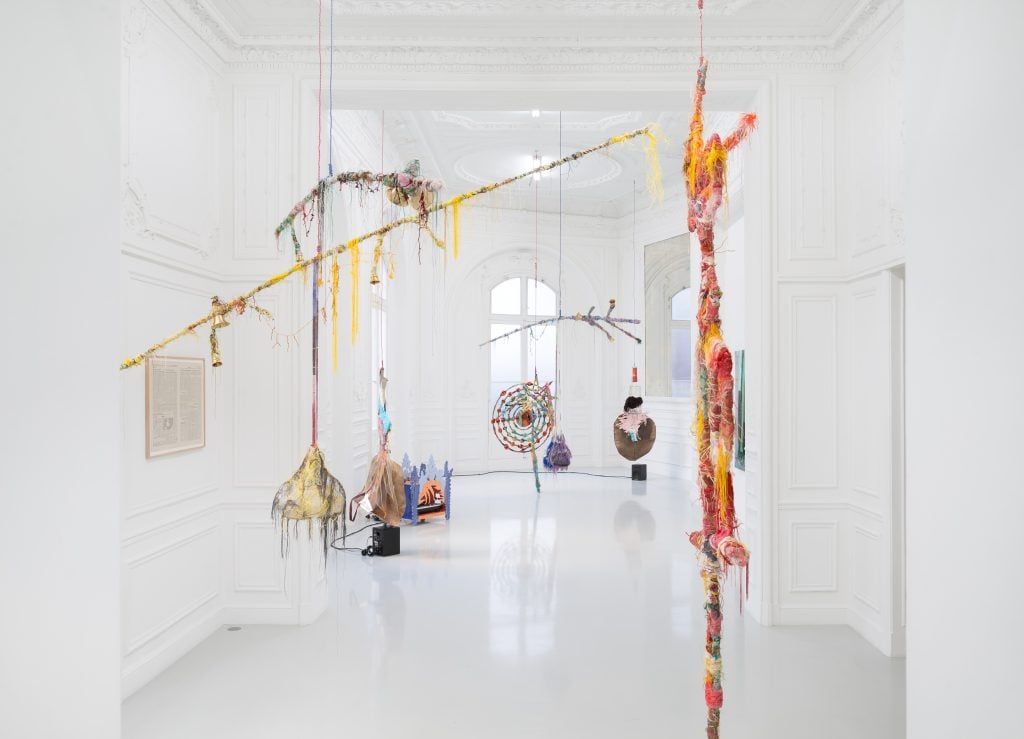
Installation view of Julien Creuzet’s “The Possessed of Pigalle or the Tragedy of King Christophe” at High Art, Paris. Courtesy the artist.
The nature of Creuzet’s work, which is personal, political, and biographical, has caused him to ponder as he faces the major platform of the Venice Biennale. He is carefully evaluating what he wants to share in an exhibition. “I didn’t expect it,” he said of his nomination. “The Venice Biennale is above all a complex economic montage and I’m not an artist whose economy is speculative. It’s something that one needs to think about—what does that mean for me […], what do I want to profoundly share with the public coming to Venice.”
In his Paris show, Creuzet has been open-hearted. In the first of the four rooms, Creole singing and pulsating rhythms emanate from a turntable and large black heads that are festooned with fragments of raffia bags. Nearby, two conjoined forms of concentric circles fashioned from plastic, threads, and beads allude to clouds being bombed with silver iodide molecules to summon the rain during a drought.
In the adjoining rooms, suspended sculptures filled with grains, rice, and beans recall offerings to Demeter—the Greek goddess of the harvest, while amorphous sculptures with trailing threads evoke the detritus, pollution and seaweed of fishing villages and fishing nets. Roosters, which are emblematic of France, have settled on, or become trapped in, one of these intricately-made pieces.
Some of the sculptures on view gestated in Creuzet’s studio in Montreuil, a commune east of Paris, for three or four years before coming into being. “It’s as if the studio were a place of experimentation [and some pieces] need time to find their resolution,” Creuzet said. “One day, suddenly there are elements that take on all their meaning and end up organizing themselves and writing things. There’s a moment when the sculpture escapes me and I almost no longer have the impression of having been its author. This is the moment when the sculpture is finished and becomes a work for me.”
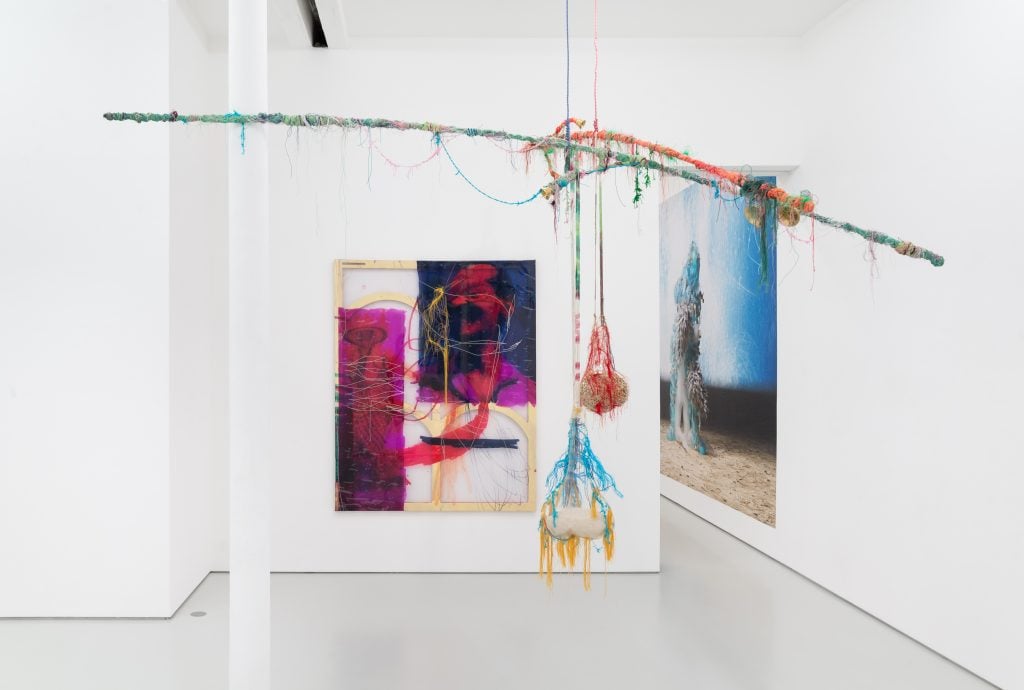
Installation view of Julien Creuzet’s “The Possessed of Pigalle or the Tragedy of King Christophe” at High Art, Paris. Courtesy the artist.
Born in 1986 in Le Blanc Mesnil, a suburb north-east of Paris, Creuzet moved to Martinique with his parents at the age of four. His father, an assistant nurse, loved art and took the artist and his younger brother to see exhibitions and cultural events taking place on the island. At the age of 20, Creuzet returned to France to study art. An epiphany was visiting Documenta 13, curated by Carolyn Christov-Bakargiev in 2012, featuring works by, among others, Ryan Gander, Anri Sala, and Pierre Huyghe. “I discovered the curatorial beauty of an exhibition and it made me want to do my job,” he reminisced.
Over the last decade, Creuzet has developed a transdisciplinary practice that encompasses poetry, performance, singing, and composing as well as visual art. An early start was his exhibition “Opéra-archipel” at Frac Basse Normandie in 2015, named in homage to the Martinican poet Édouard Glissant; in the show, Creuzet explored how the ocean links the archipelago of Caribbean islands.
A big break came in 2021, when he was nominated for the prestigious Prix Marcel Duchamp. For the show, he presented a sweeping installation at the Centre Pompidou that reflected upon slavery while interweaving vibrancy and poetry. Then last December, Creuzet won the first edition of the Étant Donnés Prize awarded by CPGA (French Professional Committee of Art Galleries) and Villa Albertine to a living artist active in France and exhibiting at Art Basel Miami Beach. Creuzet’s work was on display at High Art and Andrew Kreps Gallery from New York.
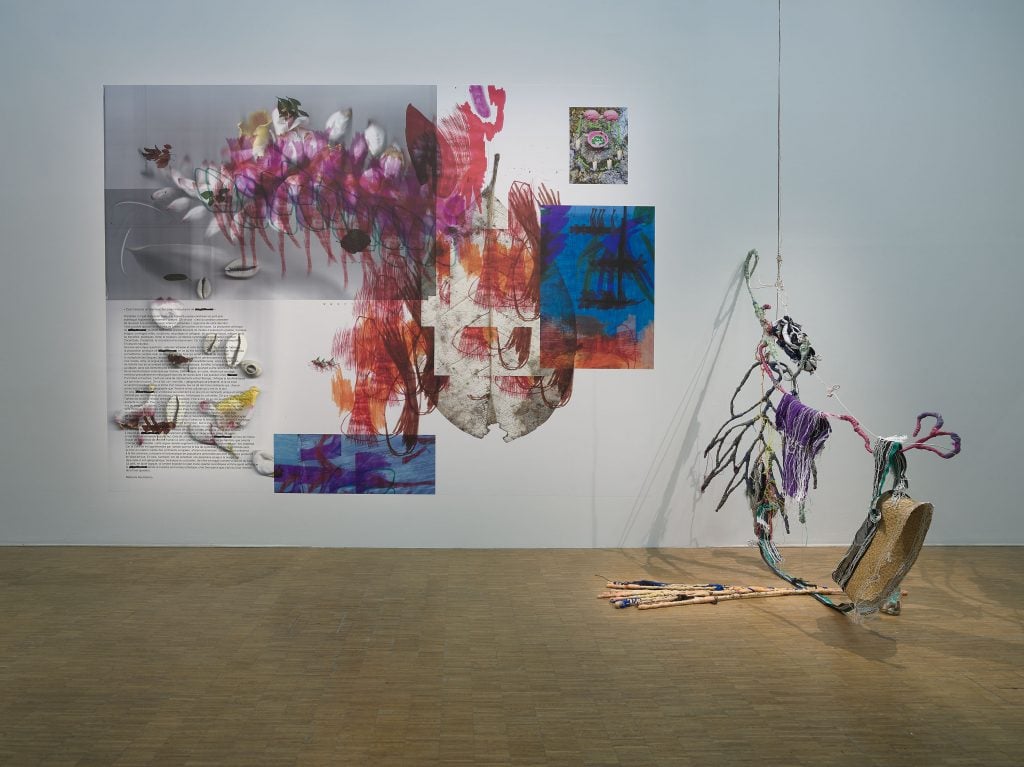
Installation view for “Prix Marcel Duchamp” at Centre Pompidou in 2021. Photo: Bertrand Prévost
Concurrently with the show at High Art, Creuzet has an exhibition view at Luma Westbau in Zurich (running until May 21). He will also participated in the Liverpool Biennial, opening in June.
“His attachment to poetry leads him to intertwine stories and navigate in time and space,” said Bernard Blistène, who was director of the Centre Pompidou when Creuzet was nominated for the Prix Marcel Duchamp. “Colonial history is […] underground, unforgivable, and unforgiven, leading Creuzet to combine politics and poetry through stories from the past and stories to be written.”
Creuzet flew back to Martinique for the first time in a decade that same year. Seeing how much it had changed and realizing how out-of-step he felt linguistically was “like a shock,” he said. “I understood that I should go home more often, because that’s where my emotions, imagination, and family come from,” he noted.
For his exhibition at High Art, Creuzet has returned to his contemplation of the ocean with regard to the displacement and migration of the African diaspora. In his hybridized painting-sculptures, the cruciforms of the chassis have been removed and replaced with vegetal forms, featuring barely perceptible, indistinct figures among swirling aquatic shapes, threads, and beads. Creuzet likens the figures to extras in a film—unknowable, background characters who are nonetheless crucial to a scene.
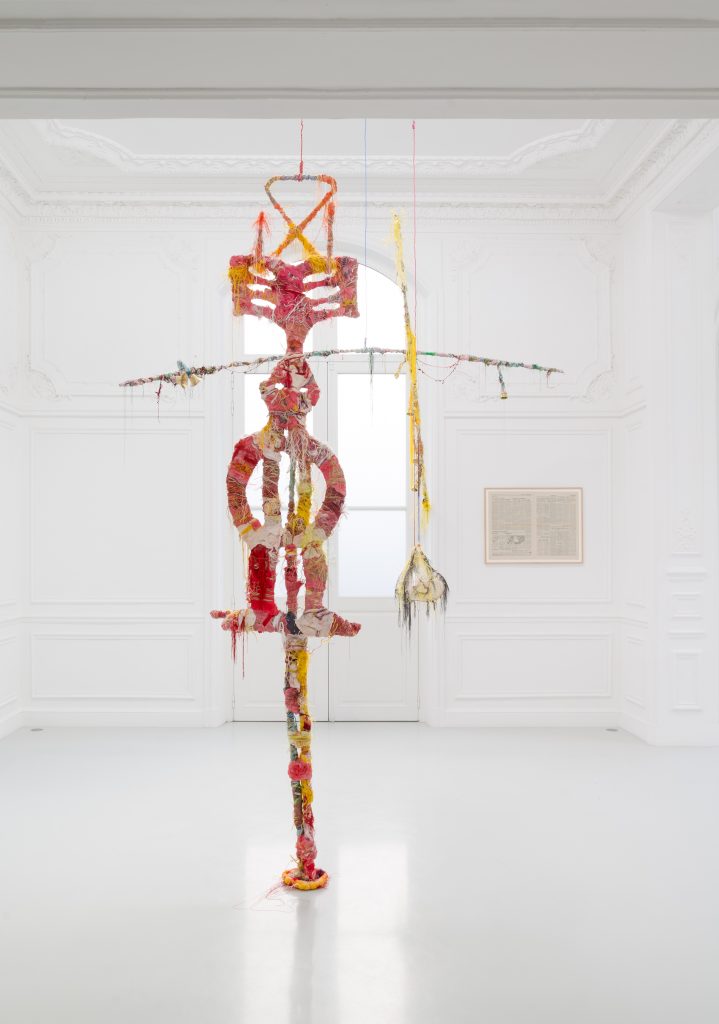
Installation view of Julien Creuzet’s “The Possessed of Pigalle or the Tragedy of King Christophe” at High Art, Paris. Courtesy the artist.
“From a distance, I manage to identify or project myself into the stories or lack of them [of the figures],” Creuzet said. “When I say ‘lack’, I’m thinking of this unresolved quest of an Afro-descendant who can’t trace his family tree. It’s as if my forefather were the sea, mon arrière-arrière-arrière-la-mer, mon arrière-arrière-arrière-océan,” he said mournfully. The poetic words translate to “my great, great, great sea, my great, great, great ocean,” in reference to ancestry.
It was perhaps thinking about a figure who traverses time and space that inspired Creuzet’s avatar-like character that reappears and evolves in his exhibitions. At Camden Art Centre in 2022, where Creuzet had a show after winning its Emerging Artist Prize during Frieze London, it also appeared. Martin Clark, director of Camden Art Centre, noted that the character was “pulling books from their head that formed a bibliography of diaspora, African, and Caribbean writers which had informed Julien’s thinking” in one video work and “dancing a very particular Caribbean dance of protest, independence and resistance” in another.
At High Art, this as-yet-unnamed character, which has grown protrusions of feathers at the tips of their hands, appears in a wallpaper piece and an animated video work. In the latter, the figure performs the bèlè dance, which developed in Martinique during slavery, against a changing, blue-hued backdrop interspersed with bountiful flowers and man-made elements. It is accompanied by Creuzet singing in Creole.
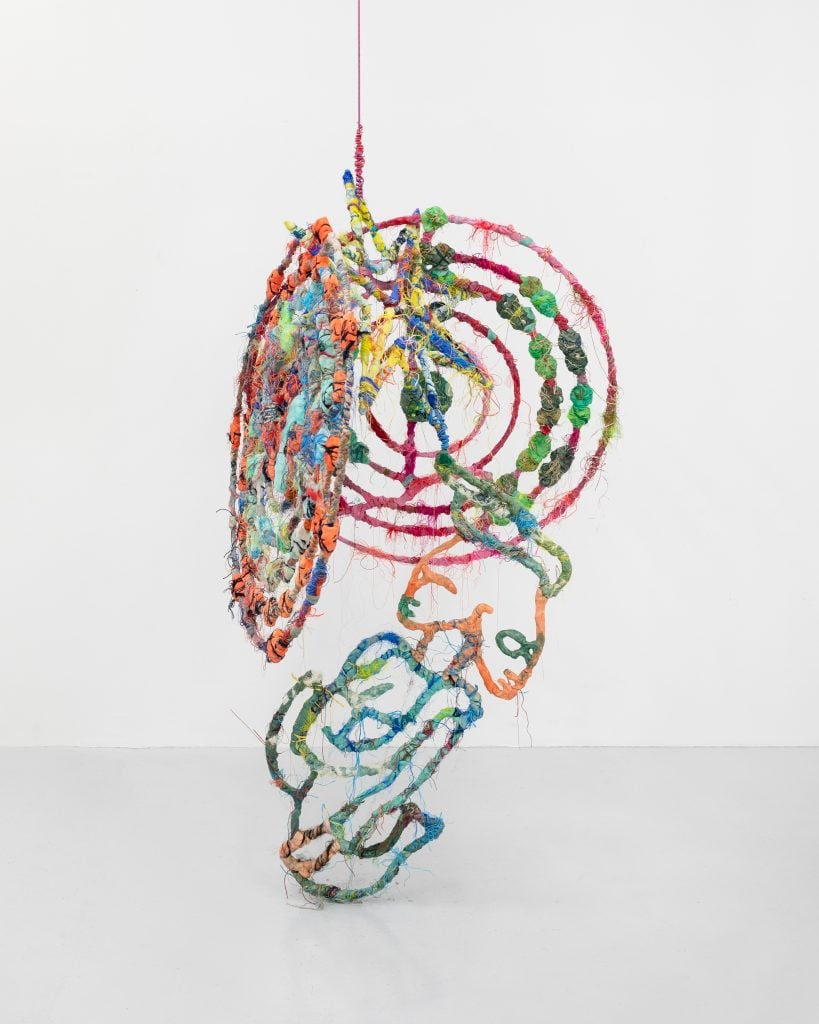
Julien Creuzet The Possessed of Pigalle or the Tragedy of King Christophe: „ RAFT-KEEPER CAPTAIN: Well it’s there that we have to push hardest. And we got no choice. On the Great Salty, someone will throw you a rope. If you catch it, that’s fine, you’ll reach land and moor there. If you fail, God help you! Then all you can do is throw yourself in the arms of Mama Water.”, (2023). Courtesy of the artist and High Art, Paris / Arles
Creuzet is evidently excited by the new exhibition. Yet he regrets that some of his works cannot easily reach a public in Martinique. For instance, in 2019 he made a video work, Mon corps, carcasse […], about chlordecone, a pesticide that was used in banana plantations in the French Caribbean from 1972 until 1993, three years after it was banned in France in 1990. According to France’s health ministry, around 90 percent of the population in Martinique and Guadeloupe were contaminated. Following a 16-year-long investigation, a French court decreed the closure of proceedings in a case about contamination in January.
“It would have been good if this work about chlordecone had been visible to people who were contaminated,” Creuzet said. Referring to how a limited-edition work acquired by a museum tends not to be diffused via YouTube or other virtual channels, he added: “These systems could be tested and modified. I’m interested in NFTs in terms of how a work has a digital code and identification that enables it to be shown more widely.”
For now, at least, he focuses on his largely European and American-based audience. As Creuzet surveyed the show at High Art, he emphasized how he wanted visitors “to live an experience” in his exhibitions. “When one leaves, one will have gone through sensations and emotions, joyful and tense moments, without it becoming something heavy and sad,” he said. “There’s joy and emancipation in the atmosphere that I want to share.”
“The Possessed of Pigalle or the Tragedy of King Christophe” is on view at High Art, Paris, until April 8, 2023.
More Trending Stories: